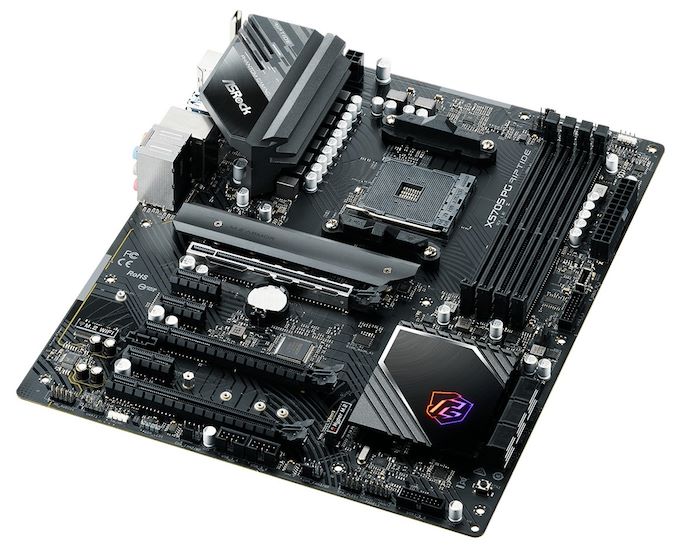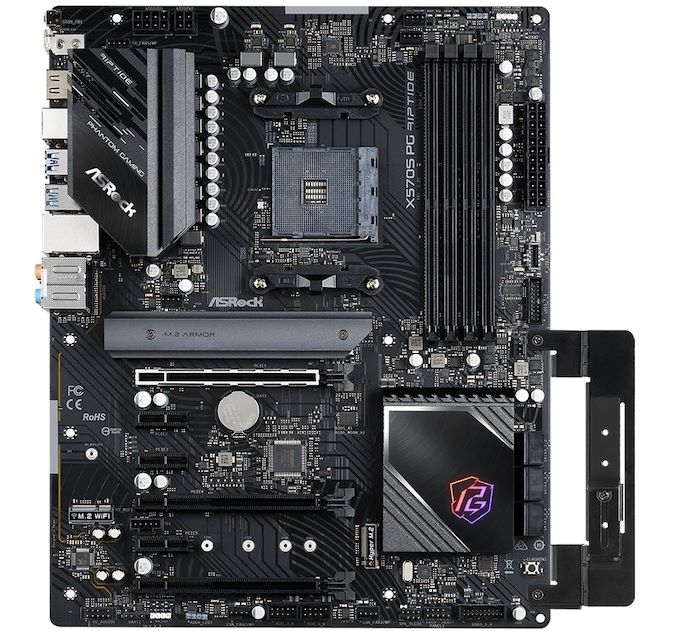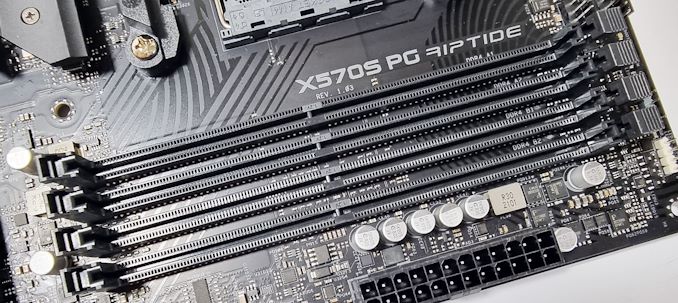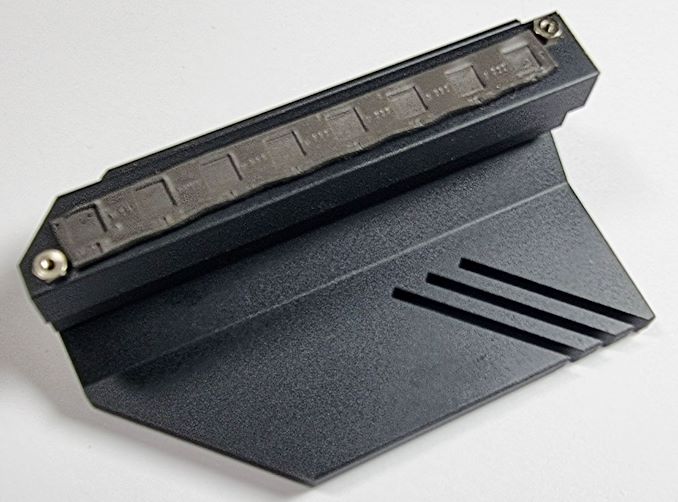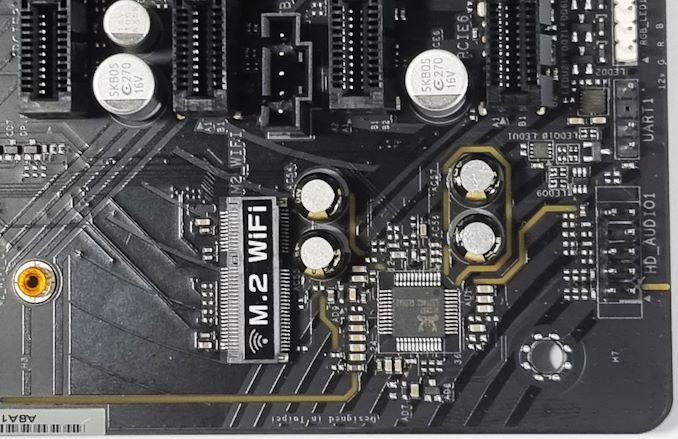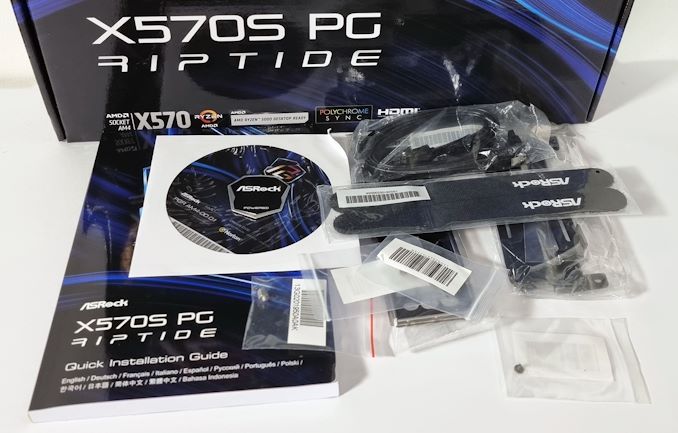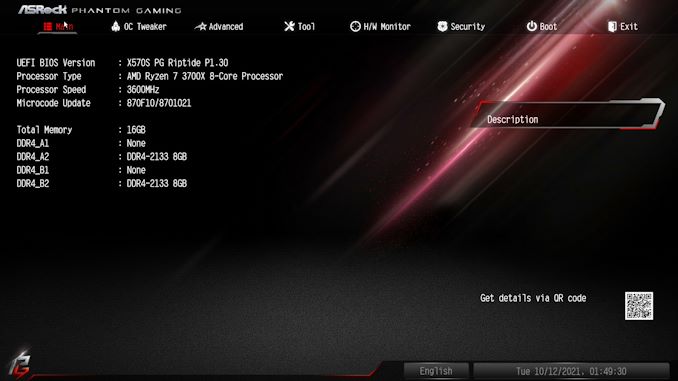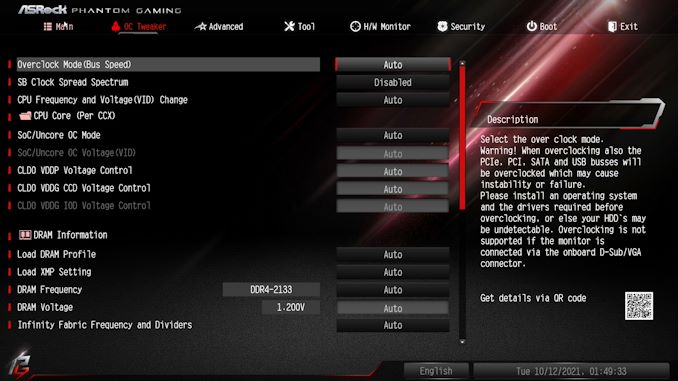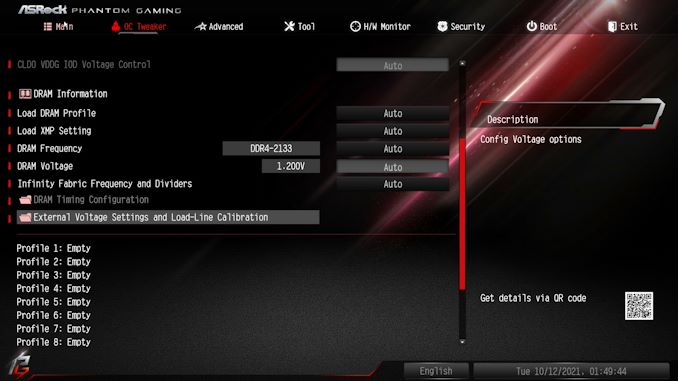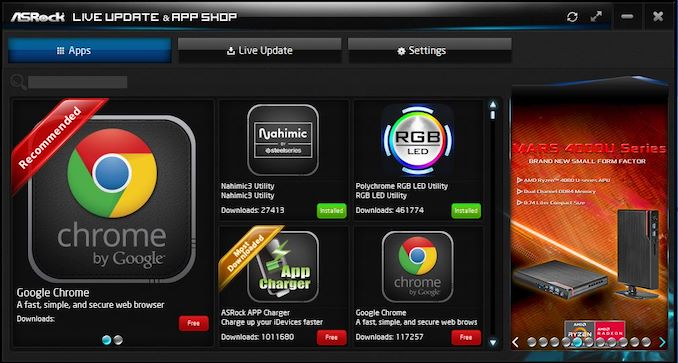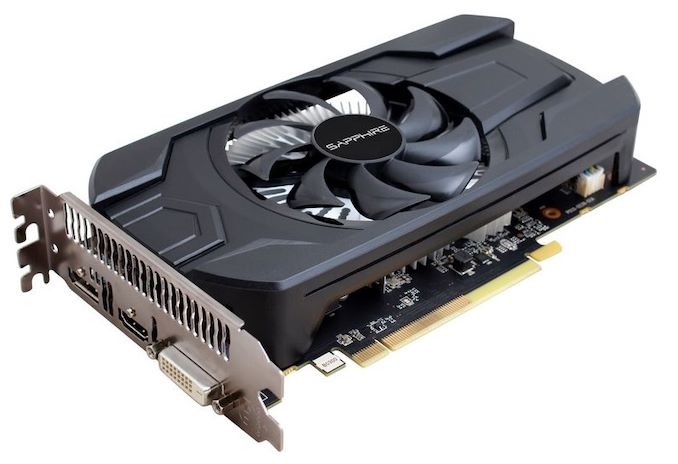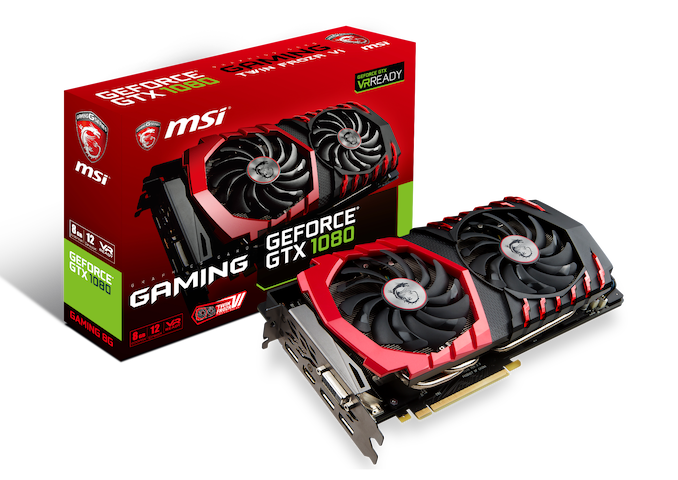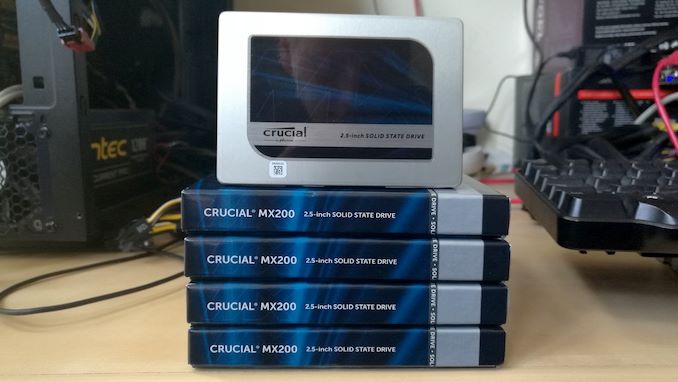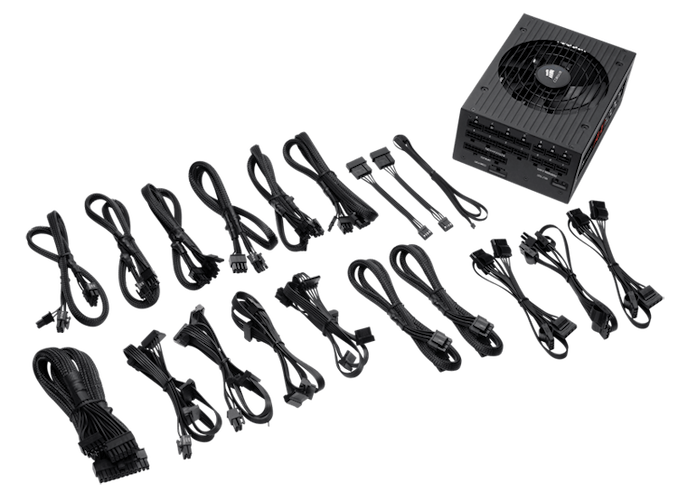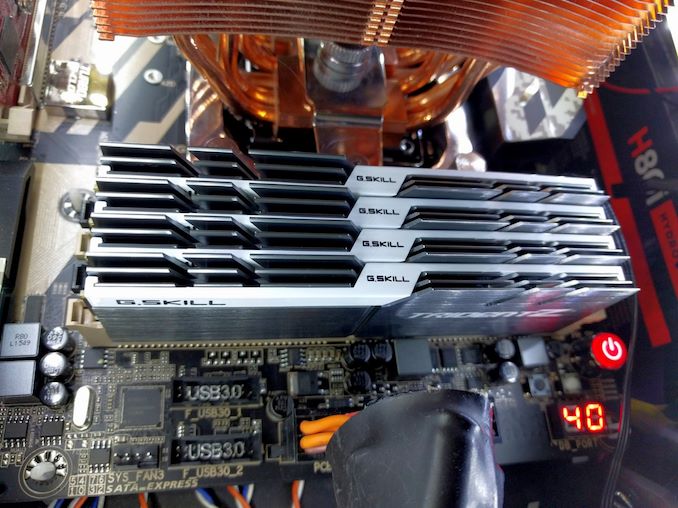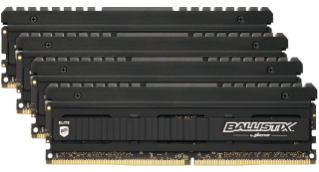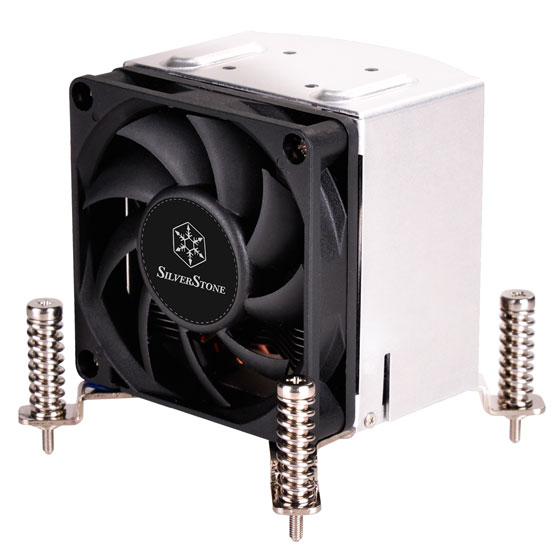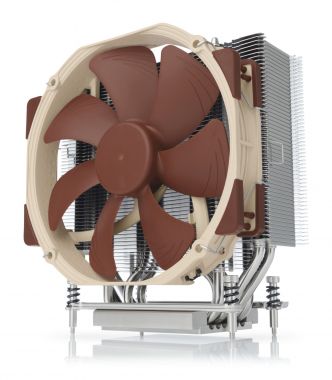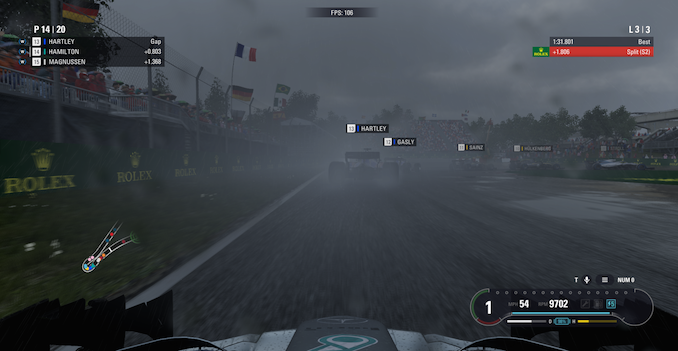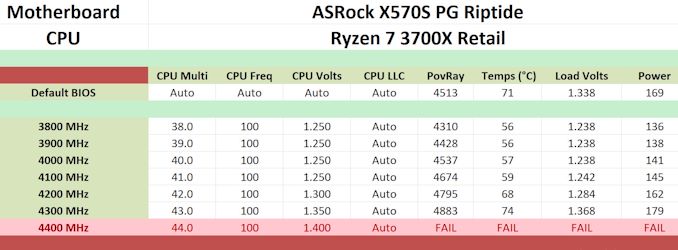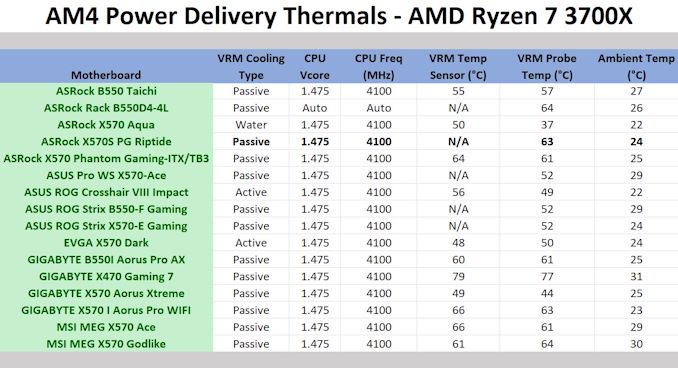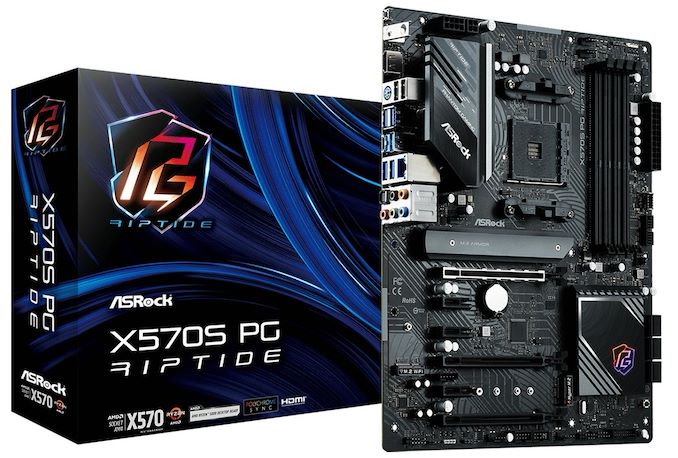
Original Link: https://www.anandtech.com/show/16973/the-asrock-x570s-pg-riptide-motherboard-review
The ASRock X570S PG Riptide Motherboard Review: A Wave of PCIe 4.0 Support on A Budget
by Gavin Bonshor on October 22, 2021 9:00 AM EST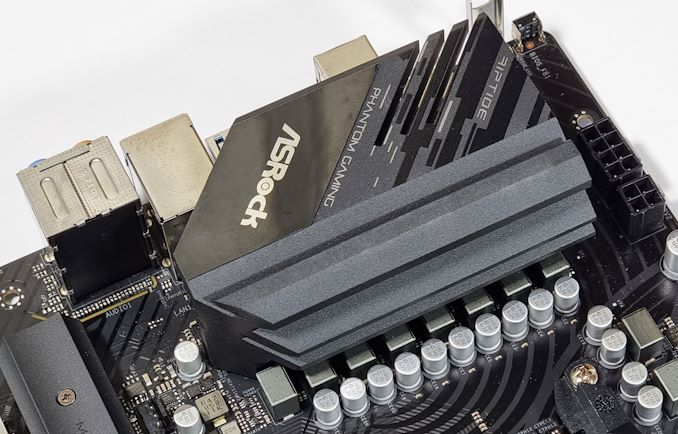
Officially announced at Computex 2021, AMD and its vendors unveiled a new series of AM4 based motherboards for Ryzen 5000 processors. The new X570S chipset is, really, not that different from the previous version launched back in 2019 from a technical standpoint. The main user difference is that all of the X570S models now feature a passively cooled chipset. Some vendors have opted to either refresh existing models, or others are releasing completely new variants, such as the ASRock X570S PG Riptide we are reviewing today. Aimed at the entry-level extreme chipset, the X570S PG Riptide features a Killer-based 2.5 GbE controller, dual PCIe 4.0 x4 M.2 slots, and support for up to 128 GB of DDR4-5000.
ASRock X570S PG Riptide: The Tide is High
At the launch of the original X570 chipset back in 2019, many users stressed that they were worried that the actively cooled chipset heatsinks were going to generate extra noise, or by using smaller fans they would fail early. In reality, the chipset fans didn't generate THAT much noise, but for some users, they still expressed their annoyance. Fast forward to 2021, and at Computex 2021, the latest X570S chipset models now feature passively cooled chipset heatsinks. Another avenue that the X570S chipset brings to the table is that motherboard vendors have been able to refresh some of its previous X570 models and added more up-to-date controller sets, extending their offerings with the latest and greatest.
The ASRock X570S PG Riptide represents a new entry in ASRock's gaming-themed Phantom Gaming series, but at the more entry to a mid-level market segment, which for an X570 board might be most people's mid-range or even high-end for cost. Designed primarily for AMD's latest Ryzen 5000 processors, it is also compatible with both the Ryzen 3000 and 2000 series of desktop processors, but it also supports Ryzen 5000, 4000, and 3000 APUs. It also has four memory slots with support for fast DDR4-5000 memory, with a maximum combined capacity of up to 128 GB.
ASRock adopts a more simplistic aesthetic for its X570S PG Riptide, with a mixture of grey, black, and silver throughout. ASRock is advertising a 10-phase power delivery cooled by a single heatsink that doubles up as a rear panel cover. The passively cooled X570S chipset keeps things quieter than the previous generation, with a smidgen of integrated RGB LED lighting. If that's not enough for some users, ASRock includes two addressable RGB and two regular RGB headers to add additional RGB LED strips to jazz up their systems.
The ASRock X570S PG Riptide offers a more affordable route to the full levels of PCIe 4.0 support that both Ryzen 5000 and X570 combined offer uses. For PCIe slot support, ASRock includes one full-length PCIe 4.0 x16 slot, one full-length PCIe 4.0 x4 slot, one full-length PCIe 4.0 x2, and three PCIe 4.0 x4 slots. ASRock also includes PCIe 4.0 storage support via two PCIe 4.0 x4 M.2 slots, with six SATA ports compatible with AMD RAID 0, 1, and 10 arrays. Other notable features include one of the latest Killer-based 2.5 GbE controllers, with USB 3.2 G2 Type-A and Type-C connectivity on the rear panel, as well as a mid-range HD audio codec driving the board's audio. For users looking to add wireless capabilities, the ASRock X570S PG Riptide does have an additional M.2 Key-E for users to add their own M.2 2230 Wi-Fi and BT modules.
Touching on performance, the ASRock X570S PG Riptide performed competitively against other AM4 boards we've tested, with a decent showing in our system tests such as POST time testing and power consumption. In our DPC latency testing, it wasn't anything special, and performance in our compute and gaming tests put it exactly where we would expect it to be, in competition with the rest of the field.
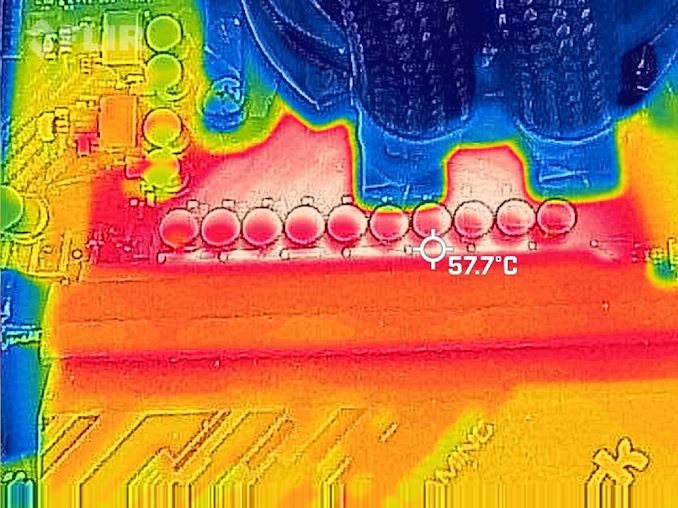
The ASRock X570S PG Riptide undergoing our VRM thermal testing
Regarding overclocking, the ASRock also performed creditably given it's at the lower end of X570/X570S models currently available in terms of price. We managed to overclock our testbed AMD Ryzen 7 3700X to 4.3 GHz all-core stable, which is standard for most AM4 boards we've tested. Still, the board exceeded our expectations regarding tight VDroop control at load compared to the values we set for the CPU VCore in the firmware. The board's VRM thermal performance was also acceptable, even if it ran warmer than the more premium models we've tested.
Looking at pricing, the ASRock X570S PG Riptide has an MSRP of $185, which if you compare it to other X570 models in its arsenal, such as the ASRock X570 Steel Legend ($200), the PG Riptide has a much more up-to-date and premium Ethernet controller, as well as better memory support out of the box. Believe it or not, there's not much in the way of available X570S boards at both Amazon, Newegg, or Microcenter to actually compare the PG Riptide to.
One equally competitive model in the realm of X570S is the MSI MAG X570S Torpedo Max, which costs around $200 and uses 2.5 GbE, a secondary Gigabit LAN port as well as a much more recent HD audio codec. Whether a user's motherboard selection is dependent on features, price, aesthetic, or a combination of all three, the ASRock X570S PG Riptide looks interesting in the sub $200 market. The biggest question, however, from our point of view, is how does it stack up against other AM4 models we've tested so far. It's time to take a closer look and see what if the ASRock X570 PG Riptide can hold its own in shark-infested waters.
Read on for our extended analysis.
Visual Inspection
The ASRock X570S PG Riptide uses a more neutral color scheme with black and silver throughout, including the rear panel cover, the M.2 heatsink, and the chipset heatsink. Built into the passively cooled chipset heatsink is an illuminated PG (Phantom Gaming) logo, which can be customized via the ASRock Polychrome RGB software. Users looking to add extra RGB can do so via two addressable RGB and two regular RGB headers.
For cooling, ASRock includes seven 4-pin headers in total, with one designated as a CPU fan, one for an optional CPU fan and water pump, and five for chassis fans and water pumps. Other notable headers include a 5-pin Thunderbolt AIC card header, a front panel USB 3.2 G2 Type-C header, two USB 2.0 headers (four ports), and two USB 3.2 G1 Type-A headers (four ports).
Dominating the lower section of the board is plenty of PCIe real estate for a budget board. This includes three full-length PCIe 4.0 slots that can operate at x16/x4/x2, with three smaller PCIe 4.0 x1 slots. For storage, ASRock has one PCIe 4.0 x4 M.2 slot, one PCIe 4.0 x4 with SATA support, and six SATA ports with support for AMD RAID 0, 1, and 10 arrays. The top-mounted PCIe 4.0 x4 slot includes an M.2 heatsink, while the second slot does not. ASRock also has its patent-pending graphics cardholder, which helps reduce sag from heavy graphics cards.
In the top right-hand corner of the board are four memory slots with support for up to 128 GB. In terms of speed, the PG Riptide supports memory with speeds of up to DDR4-5000 out of the box when used with a Ryzen 5000 series processor.
Looking at the power delivery on the X570S PG Riptide, ASRock is advertising a 10-phase design. Dissecting it, the power delivery is controlled by a UPI UP9595S PWM controller operating in a 4+2 configuration. ASRock includes eight Vishay SIC654 50 A power stages with dual UPI UP1911R smart PWM doublers for the CPU section, making it a doubled 4-phase design from a technical standpoint. On the SoC section, ASRock is using two independently operated Vishay SiC654 50 A power stages. It's not as over-engineered as some power deliveries, but for the price point, it's more than enough to operate Ryzen 5000 without issues.
ASRock is using a simple power delivery heatsink which doubles up as the board's rear panel cover. The design is more about catching passive airflow over high levels of mass, which means it should handle an overclocked processor as this is the only section of the VRM the heatsink covers. The SoC section of the power delivery is solely reliant on passive airflow directly over the bare power stages.
Focusing on the audio section of the board's components, ASRock uses a Realtek ALC897 HD audio codec, which is aging, yet still entirely acceptable for an entry-level model today. Assisting the HD audio codec are four Japanese gold Nichicon audio capacitors, with a front panel header available for users to use. There is also a small line of separation between the audio PCB and the rest of the board.
The rear panel of the ASRock X570S PG Riptide is one USB 3.2 G2 Type-C, one USB 3.2 G2 Type-A, four USB 3.2 G1 Type-A, and two USB 2.0 ports. Also present is a PS/2 combo port for legacy peripherals, five 3.5 mm audio jacks, and S/PDIF optical output powered by a Realtek ALC897 HD audio codec, as well as a single HDMI 2.1 video output for users looking to utilize AMD's Ryzen APUs. ASRock includes a blanking plate for the installation of an M.2 Key E Wi-Fi adapter, while a small BIOS Flashback button finishes off a modest rear panel.
What's in The Box
The main bulk of the accessories within the ASRock X570S PG Riptide box include a pair of SATA cables, ASRock's graphics card holder, three M.2 screws, and one M.2 standoff. There is also a quick installation guide, a software and drivers installation disc, and a rear I/O shield.
- Quick installation guide
- Software/Driver installation disc
- 2 x SATA cables
- 3 x M.2 installation screws
- 1 x M.2 standoff
- ASRock Graphics Card Holder
- 2 x Velcro cable ties
- Rear I/O shield
- ASRock case badge
BIOS
ASRock is using a consistent and familiar UEFI firmware across its Phantom Gaming series models for AMD's AM4 socket. The GUI consists of a primarily black background with red futuristic highlights, white text, and red highlighting when hovering over an option or menu.
The ASRock X570S PG Riptide UEFI firmware has just one mode which is resemblant of its Advanced modes on models that feature an EZ Mode as well. The main part of the firmware has plenty of menus to select from including (from left to right), the Main screen, the OC Tweaker, the Advanced section, the Tool menu, a H/W Monitor panel, a Security menu, a Boot menu, and an Exit menu.
The area where users can overclock is the OC Tweaker, which has plenty of options for users looking to overclock both the memory and processors. Users with AMD Ryzen APUs can also overclock the integrated Radeon graphics, with the options greyed out on unsupported processors.
There are many options for a budget board such as this in terms of both processor and memory overclocking, although much of it is simplified for users. Users can simply alter the CPU Frequency ratio and CPU VCore voltage and overclock the processor, although there are advanced CPU options such as Loadline Calibration and other voltage options to consider.
Users can also enable X.M.P 2.0 memory profiles on compatible memory kits with a couple of clicks, or alternatively, users can do this manually. ASRock provides lots of latency options for users looking to fine-tune their kits, providing there's any give or take in terms of overclocking. Users can also alter the Infinity Fabric Clock speed (FCLK), with the idea that it operates in a 2:1 ratio to provide the most effective levels of performance. The achievable FCLK varies on the chip, but a memory speed of DDR4-3600 and FCLK of 1800 MHz is seemingly achievable for most and is the sweet spot recommended by AMD.
While the level of customization for a board at this kind of price point lacks in some key areas to what we're used to. There is a basic element of its integrated FAN-Tastic fan tuning utility, but the firmware-based Polychrome RGB utility is lacking any visual expression, instead, users have to use color codes which is abysmal in this day and age. ASRock could be better as previously mentioned, but the rest of the firmware is fine, it's responsive, it's intuitive (aside from the parts mentioned above), and with more customization on the fan control and RGB LED lighting, it would be more than adequate.
Software
Compared to other AM4 boards from ASRock we've covered, the software bundle supplied with the X570S PG Riptide is very basic. The main software applications come via the Live Update and App Shop, with a Restart to UEFI which is a functional piece of software, as well as the Nahimic 3 audio software.
The ASRock Live Update and App Shop allows users to download the latest version of the software that is compatible with the X570S PG Riptide. It also allows users to download up-to-date drivers for the board including controller drivers such as networking, as well as AMD's latest chipset drivers at the click of a button.
Unfortunately, the ASRock X570S PG Riptide doesn't come supplied with any overclocking software such as A-Tuning or the Phantom Gaming series variant. Users looking to access overclocking tools within Windows can easily download the AMD Ryzen Master tuning utility, which we've used with great success previously and is very intuitive and easy to use. ASRock does include Nahamic too which is designed to enhance a user's auditory experience, and the Restart to UEFI software is also useful for directly booting into the firmware at the click of a button.
Overall it's not a feature-packed software bundle, but it's adequate and we still believe ASRock could have shipped one of its own overclocking software with this board.
Board Features
The ASRock X570S PG Riptide is an ATX motherboard designed for everyday users and gamers looking to use AMD's Ryzen 5000 and 3000 series on a budget. Designed around a new passively cooled chipset heatsink, the X570S series typically allows vendors to update controller sets to the latest chips, although the PG Riptide is more about squeezing in as much value as possible.
Some of the board's main features include three full-length PCIe 4.0 slots that are operating at x16/+4/+2, with three smaller PCIe 4.0 x1 slots. For storage, ASRock includes one PCIe 4.0 x4 M.2 slot, one PCIe 4.0 x4/SATA M.2 slot, and six SATA ports with support for RAID 0, 1, and 10 arrays. In the top right-hand corner of the board, there are four memory slots with support for DDR4-5000 and a maximum capacity of up to 128 GB.
Touching on cooling support, ASRock includes seven 4-pin fan headers, with one for a CPU fan, one for a water pump or second CPU fan, and five headers designed for chassis fans.
| ASRock X570S PG Riptide ATX Motherboard | |||
| Warranty Period | 3 Years | ||
| Product Page | Link | ||
| Price | $185 | ||
| Size | ATX | ||
| CPU Interface | AM4 | ||
| Chipset | AMD X570 | ||
| Memory Slots (DDR4) | Four DDR4 Supporting 128 GB Dual Channel Up to DDR4-5000 |
||
| Video Outputs | 1 x HDMI 2.1 | ||
| Network Connectivity | Killer E3100G 2.5 GbE | ||
| Onboard Audio | Realtek ALC897 | ||
| PCIe Slots for Graphics (from CPU) | 1 x PCIe 4.0 x16 | ||
| PCIe Slots for Other (from PCH) | 1 x PCIe 4.0 x4 1 x PCIe 4.0 x2 3 x PCIe 4.0 x1 |
||
| Onboard SATA | Six, RAID 0/1/10 (X570) | ||
| Onboard M.2 | 1 x PCIe 4.0 x4 1 x PCIe 4.0 x4/SATA |
||
| USB 3.2 (10 Gbps) | 1 x Type-A Rear Panel 1 x Type-C Rear Panel 1 x Type-C Header (1 x port) |
||
| USB 3.2 (5 Gbps) | 4 x Type-A Rear Panel 2 x Type-A Header (4 x ports) |
||
| USB 2.0 | 2 x Type-A Rear Panel 2 x Type-A Header (4 x ports) |
||
| Power Connectors | 1 x 24-pin ATX 1 x 8pin CPU 1 x 4pin CPU |
||
| Fan Headers | 1 x CPU (4-pin) 1 x CPU/Water Pump (4-pin) 5 x Chassis (4-pin) |
||
| IO Panel | 1 x USB 3.2 G2 Type-A 1 x USB 3.2 G2 Type-C 4 x USB 3.2 G1 Type-A 2 x USB 2.0 Type-A 1 x Network RJ45 2.5 G (Killer) 5 x 3.5mm Audio Jacks (Realtek) 1 x Optical Output (Realtek) 1 x BIOS Flashback Button 1 x HDMI 2.1 Output 1 x PS/2 Combo port |
||
In terms of connectivity, the X570S PG Riptide has one USB 3.2 G2 Type-C, one USB 3.2 G2 Type-A, four USB 3.2 G1 Type-A, and two USB 2.0 ports. Networking capability consists of a single Killer E3100G 2.5 GbE controller, while the board's five 3.5 mm audio jacks and S/PDIF optical output are controlled by a Realtek ALC897 HD audio codec. ASRock does include a BIOS Flashback button on the rear panel, as well as a single HDMI 2.1 video output for users looking to leverage the integrated graphics on Ryzen APUs.
Test Bed
As per our testing policy, we take a high-end CPU suitable for the motherboard released during the socket’s initial launch and equip the system with a suitable amount of memory running at the processor maximum supported frequency. This is also typically run at JEDEC subtimings where possible. It is noted that some users are not keen on this policy, stating that sometimes the maximum supported frequency is quite low, or faster memory is available at a similar price, or that the JEDEC speeds can be prohibitive for performance. While these comments make sense, ultimately very few users apply memory profiles (either XMP or other) as they require interaction with the BIOS. Most users will fall back on JEDEC supported speeds - this includes home users and industry who might want to shave off a cent or two from the cost or stay within the margins set by the manufacturer. Where possible, we will extend out testing to include faster memory modules either at the same time as the review or a later date.
| Test Setup | |||
| Processor | AMD Ryzen 3700X, 65W, $329 8 Cores, 16 Threads, 3.6 GHz (4.4 GHz Turbo) |
||
| Motherboard | ASRock X570 PG Riptide (BIOS P1.30) | ||
| Cooling | Cooler Master Masterliquid ML240 240 mm AIO | ||
| Power Supply | Thermaltake Toughpower Grand 1200W Gold PSU | ||
| Memory | 2x8GB G.Skill TridentZ DDR4-3200 16-16-16-36 2T | ||
| Video Card | ASUS GTX 980 STRIX (1178/1279 Boost) | ||
| Hard Drive | Crucial MX300 1TB | ||
| Case | Open Benchtable BC1.1 (Silver) | ||
| Operating System | Windows 10 1909 | ||
Readers of our motherboard review section will have noted the trend in modern motherboards to implement a form of MultiCore Enhancement / Acceleration / Turbo (read our report here) on their motherboards. This does several things, including better benchmark results at stock settings (not entirely needed if overclocking is an end-user goal) at the expense of heat and temperature. It also gives, in essence, an automatic overclock which may be against what the user wants. Our testing methodology is ‘out-of-the-box’, with the latest public BIOS installed and XMP enabled, and thus subject to the whims of this feature. It is ultimately up to the motherboard manufacturer to take this risk – and manufacturers taking risks in the setup is something they do on every product (think C-state settings, USB priority, DPC Latency / monitoring priority, overriding memory sub-timings at JEDEC). Processor speed change is part of that risk, and ultimately if no overclocking is planned, some motherboards will affect how fast that shiny new processor goes and can be an important factor in the system build.
System Performance
Not all motherboards are created equal. On the face of it, they should all perform the same and differ only in the functionality they provide - however, this is not the case. The obvious pointers are power consumption, but also the ability for the manufacturer to optimize USB speed, audio quality (based on audio codec), POST time and latency. This can come down to the manufacturing process and prowess, so these are tested.
Power Consumption
Power consumption was tested on the system while in a single ASUS GTX 980 GPU configuration with a wall meter connected to the Thermaltake 1200W power supply. This power supply has ~75% efficiency > 50W, and 90%+ efficiency at 250W, suitable for both idle and multi-GPU loading. This method of power reading allows us to compare the power management of the UEFI and the board to supply components with power under load, and includes typical PSU losses due to efficiency. These are the real-world values that consumers may expect from a typical system (minus the monitor) using this motherboard.
While this method for power measurement may not be ideal, and you feel these numbers are not representative due to the high wattage power supply being used (we use the same PSU to remain consistent over a series of reviews, and the fact that some boards on our testbed get tested with three or four high powered GPUs), the important point to take away is the relationship between the numbers. These boards are all under the same conditions, and thus the differences between them should be easy to spot.
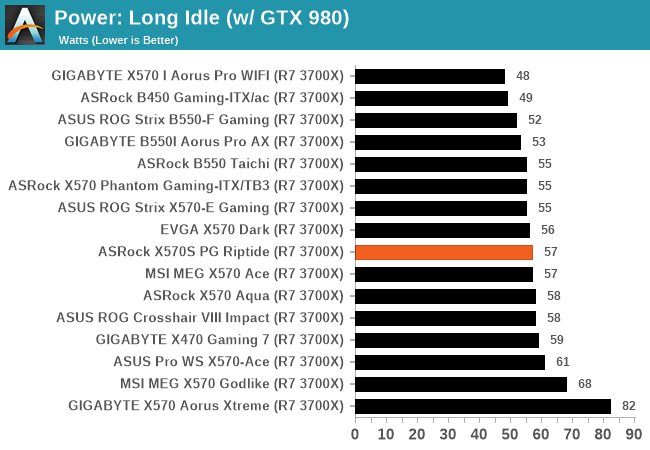
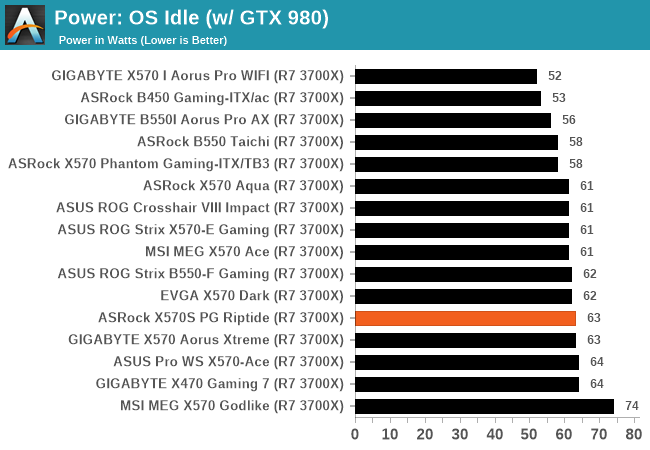
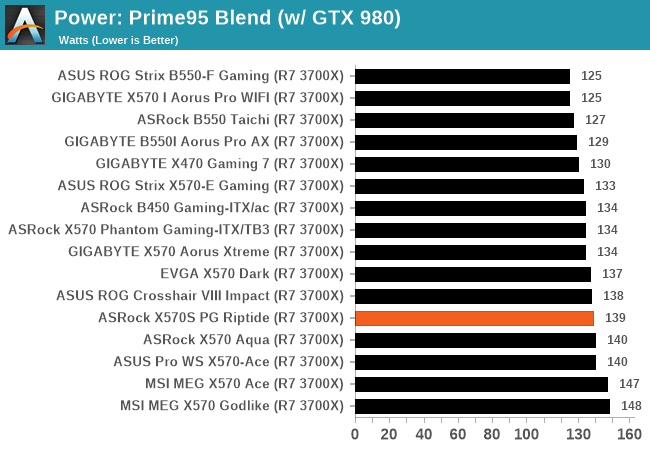
In our power testing, the ASRock X570S PG Riptide performed well with a peak output in our testing of 139 W, with middle-of-the-road power consumption in both long idle and idle power states.
Non-UEFI POST Time
Different motherboards have different POST sequences before an operating system is initialized. A lot of this is dependent on the board itself, and POST boot time is determined by the controllers on board (and the sequence of how those extras are organized). As part of our testing, we look at the POST Boot Time using a stopwatch. This is the time from pressing the ON button on the computer to when Windows starts loading. (We discount Windows loading as it is highly variable given Windows-specific features.)
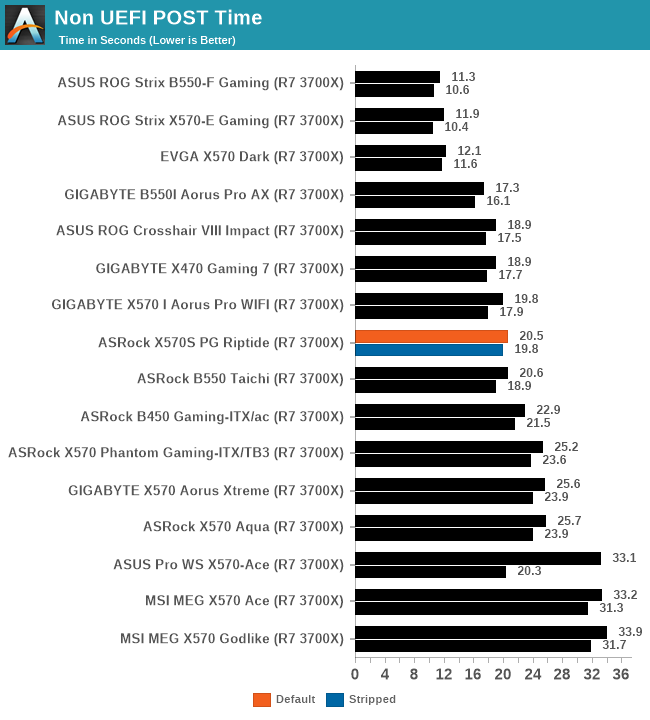
The ASRock performed creditably in our non-UEFI POST time testing, with a default booting time of 20.5 seconds, and a slightly reduced boot time of 19.8 seconds with networking and audio controllers disabled.
DPC Latency
Deferred Procedure Call latency is a way in which Windows handles interrupt servicing. In order to wait for a processor to acknowledge the request, the system will queue all interrupt requests by priority. Critical interrupts will be handled as soon as possible, whereas lesser priority requests such as audio will be further down the line. If the audio device requires data, it will have to wait until the request is processed before the buffer is filled.
If the device drivers of higher priority components in a system are poorly implemented, this can cause delays in request scheduling and process time. This can lead to an empty audio buffer and characteristic audible pauses, pops and clicks. The DPC latency checker measures how much time is taken processing DPCs from driver invocation. The lower the value will result in better audio transfer at smaller buffer sizes. Results are measured in microseconds.
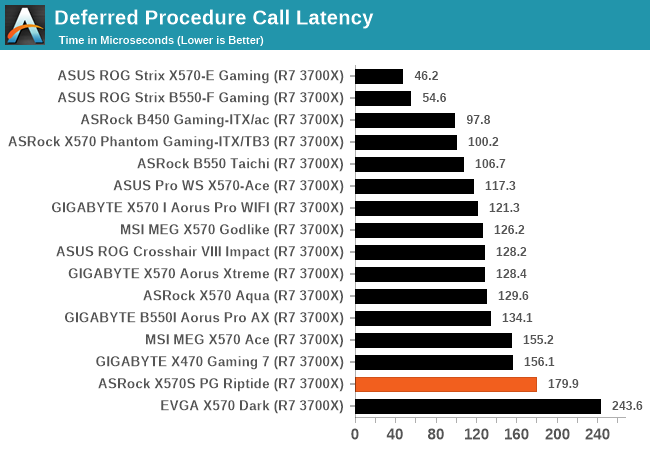
We test DPC latency out of the box at default settings, and the ASRock didn't perform as well as we've seen other ASRock models have on AM4. The result shows that the ASRock posted our second-slowest DPC latency on all the AM4 models we've tested so far.
CPU Performance, Short Form
For our motherboard reviews, we use our short form testing method. These tests usually focus on if a motherboard is using MultiCore Turbo (the feature used to have maximum turbo on at all times, giving a frequency advantage), or if there are slight gains to be had from tweaking the firmware. We put the memory settings at the CPU manufacturers suggested frequency, making it very easy to see which motherboards have MCT enabled by default.
Rendering - Blender 2.79b: 3D Creation Suite - link
A high profile rendering tool, Blender is open-source allowing for massive amounts of configurability, and is used by a number of high-profile animation studios worldwide. The organization recently released a Blender benchmark package, a couple of weeks after we had narrowed our Blender test for our new suite, however their test can take over an hour. For our results, we run one of the sub-tests in that suite through the command line - a standard ‘bmw27’ scene in CPU only mode, and measure the time to complete the render.
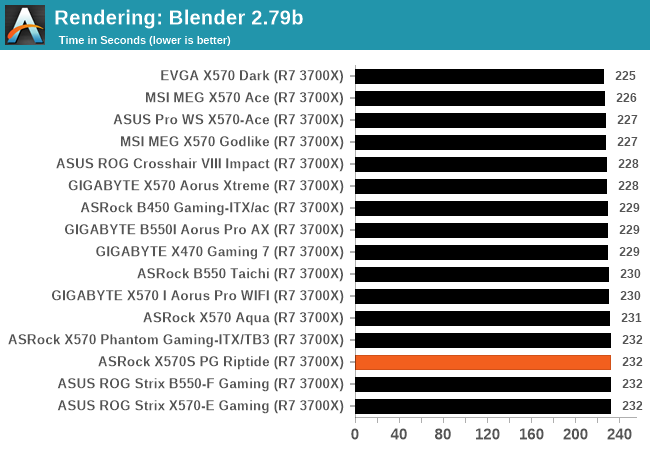
Rendering – POV-Ray 3.7.1: Ray Tracing - link
The Persistence of Vision Ray Tracer, or POV-Ray, is a freeware package for as the name suggests, ray tracing. It is a pure renderer, rather than modeling software, but the latest beta version contains a handy benchmark for stressing all processing threads on a platform. We have been using this test in motherboard reviews to test memory stability at various CPU speeds to good effect – if it passes the test, the IMC in the CPU is stable for a given CPU speed. As a CPU test, it runs for approximately 1-2 minutes on high-end platforms.
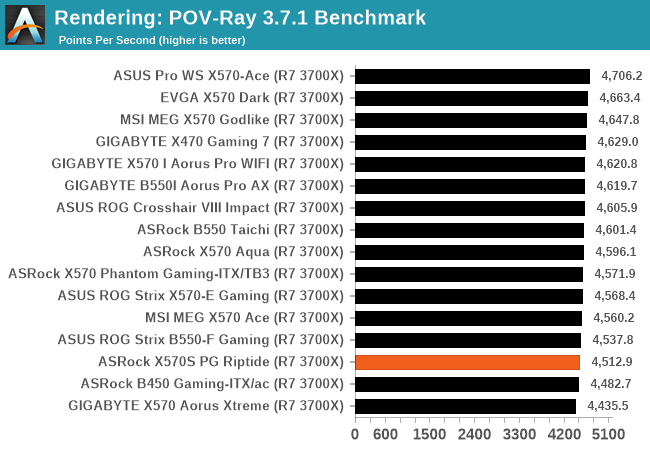
Compression – WinRAR 5.60b3: link
Our WinRAR test from 2013 is updated to the latest version of WinRAR at the start of 2014. We compress a set of 2867 files across 320 folders totaling 1.52 GB in size – 95% of these files are small typical website files, and the rest (90% of the size) are small 30-second 720p videos.
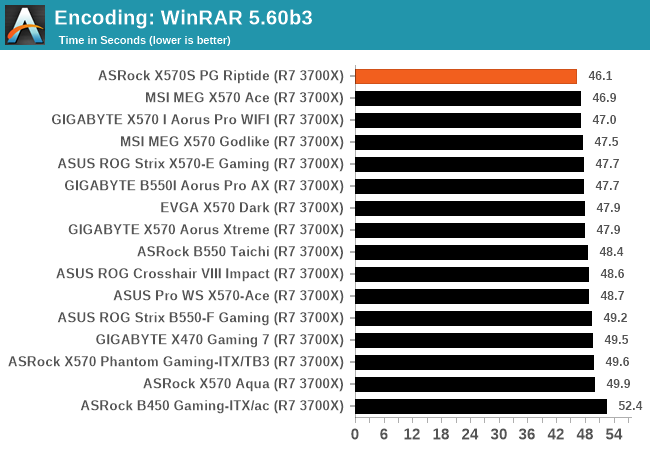
Synthetic – 7-Zip v1805: link
Out of our compression/decompression tool tests, 7-zip is the most requested and comes with a built-in benchmark. For our test suite, we’ve pulled the latest version of the software and we run the benchmark from the command line, reporting the compression, decompression, and a combined score.
It is noted in this benchmark that the latest multi-die processors have very bi-modal performance between compression and decompression, performing well in one and badly in the other. There are also discussions around how the Windows Scheduler is implementing every thread. As we get more results, it will be interesting to see how this plays out.
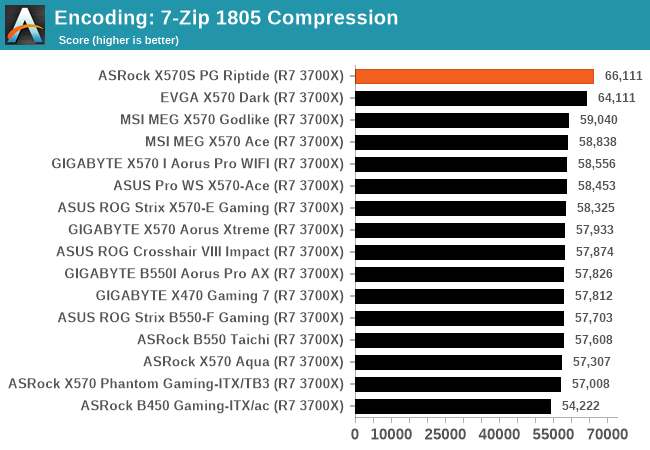
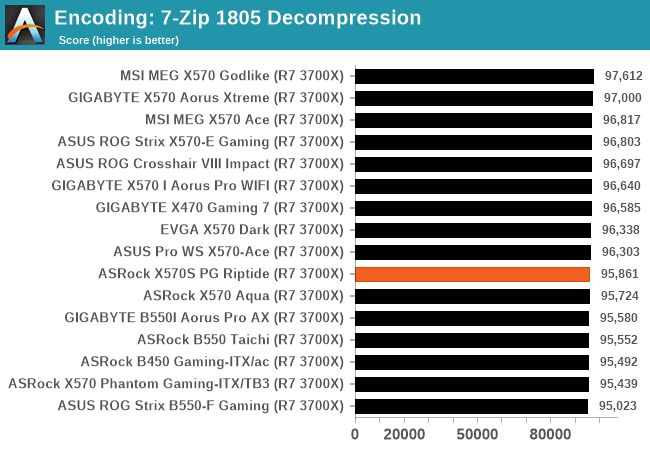
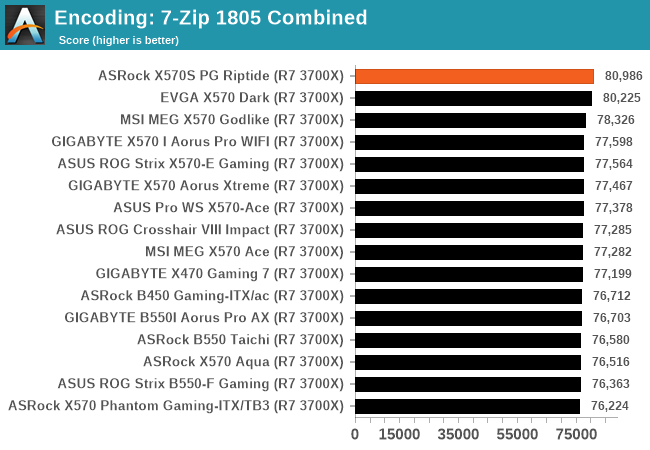
Point Calculations – 3D Movement Algorithm Test: link
3DPM is a self-penned benchmark, taking basic 3D movement algorithms used in Brownian Motion simulations and testing them for speed. High floating point performance, MHz, and IPC win in the single thread version, whereas the multithread version has to handle the threads and loves more cores. For a brief explanation of the platform agnostic coding behind this benchmark, see my forum post here.
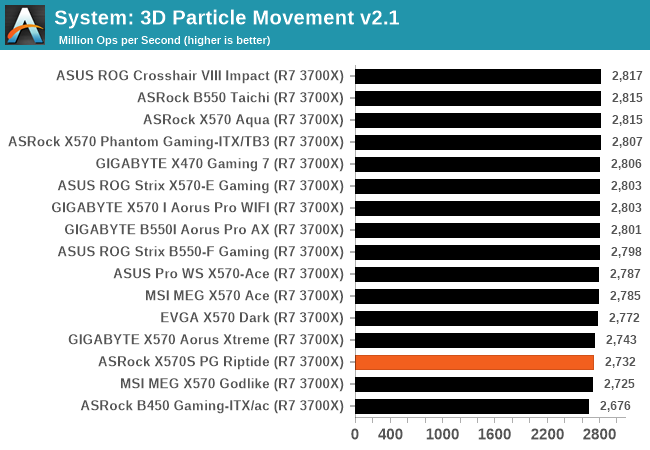
Gaming Performance
World of Tanks enCore
Albeit different to most of the other commonly played MMO or massively multiplayer online games, World of Tanks is set in the mid-20th century and allows players to take control of a range of military based armored vehicles. World of Tanks (WoT) is developed and published by Wargaming who are based in Belarus, with the game’s soundtrack being primarily composed by Belarusian composer Sergey Khmelevsky. The game offers multiple entry points including a free-to-play element as well as allowing players to pay a fee to open up more features. One of the most interesting things about this tank based MMO is that it achieved eSports status when it debuted at the World Cyber Games back in 2012.
World of Tanks enCore is a demo application for a new and unreleased graphics engine penned by the Wargaming development team. Over time the new core engine will implemented into the full game upgrading the games visuals with key elements such as improved water, flora, shadows, lighting as well as other objects such as buildings. The World of Tanks enCore demo app not only offers up insight into the impending game engine changes, but allows users to check system performance to see if the new engine runs optimally on their system.
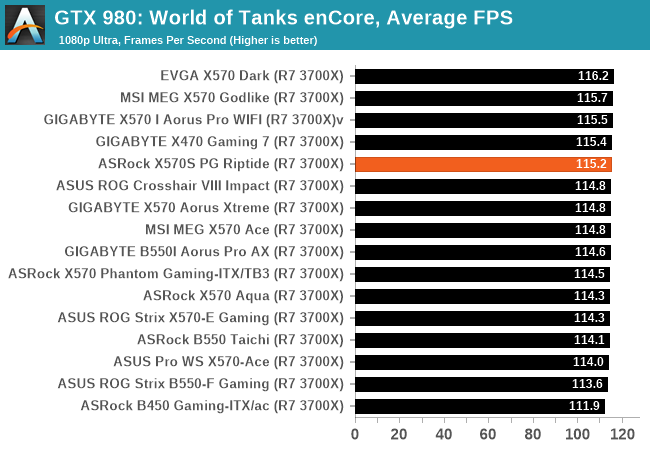
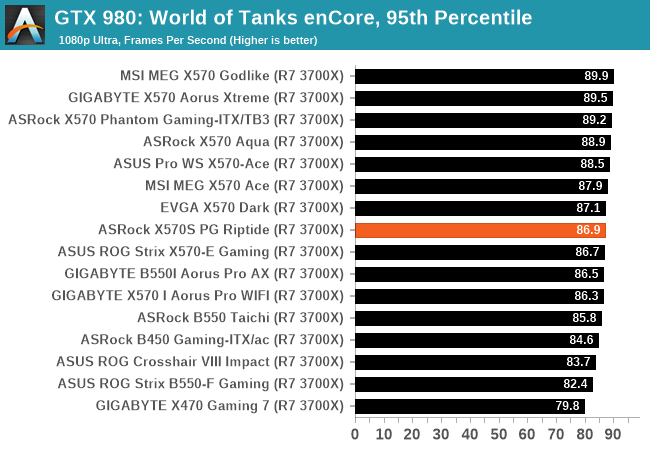
Grand Theft Auto V
The highly anticipated iteration of the Grand Theft Auto franchise hit the shelves on April 14th 2015, with both AMD and NVIDIA in tow to help optimize the title. GTA doesn’t provide graphical presets, but opens up the options to users and extends the boundaries by pushing even the hardest systems to the limit using Rockstar’s Advanced Game Engine under DirectX 11. Whether the user is flying high in the mountains with long draw distances or dealing with assorted trash in the city, when cranked up to maximum it creates stunning visuals but hard work for both the CPU and the GPU.
For our test we have scripted a version of the in-game benchmark. The in-game benchmark consists of five scenarios: four short panning shots with varying lighting and weather effects, and a fifth action sequence that lasts around 90 seconds. We use only the final part of the benchmark, which combines a flight scene in a jet followed by an inner city drive-by through several intersections followed by ramming a tanker that explodes, causing other cars to explode as well. This is a mix of distance rendering followed by a detailed near-rendering action sequence, and the title thankfully spits out frame time data.
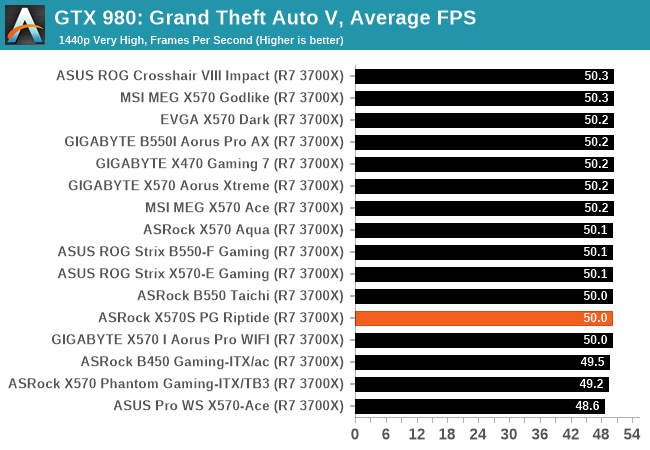
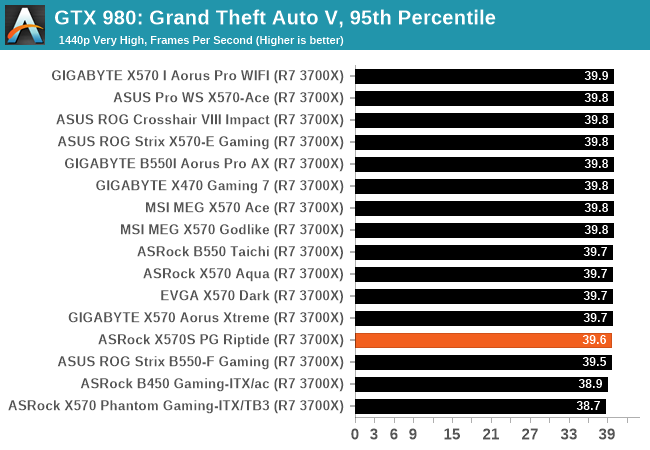
F1 2018
Aside from keeping up-to-date on the Formula One world, F1 2017 added HDR support, which F1 2018 has maintained; otherwise, we should see any newer versions of Codemasters' EGO engine find its way into F1. Graphically demanding in its own right, F1 2018 keeps a useful racing-type graphics workload in our benchmarks.
Aside from keeping up-to-date on the Formula One world, F1 2017 added HDR support, which F1 2018 has maintained. We use the in-game benchmark, set to run on the Montreal track in the wet, driving as Lewis Hamilton from last place on the grid. Data is taken over a one-lap race.
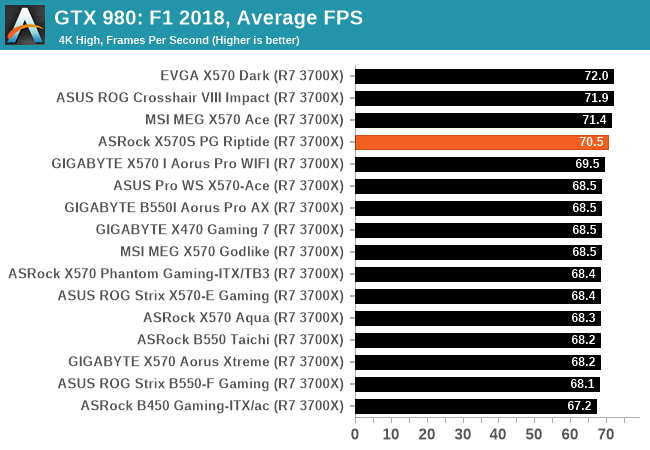
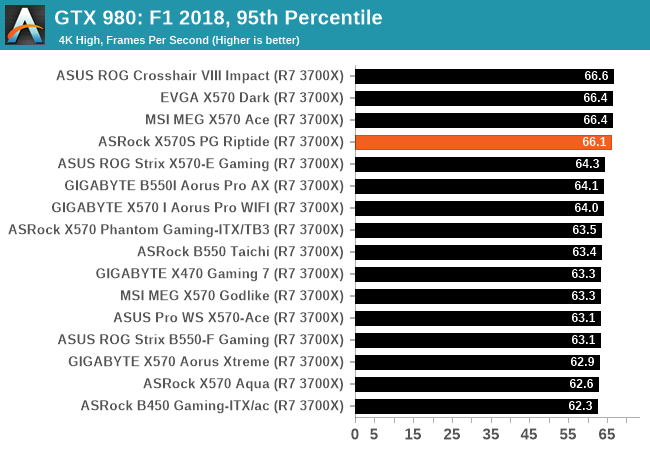
Overclocking Ryzen 3000
Experience with the ASRock X570S PG Riptide
Despite AMD's Ryzen 5000's presence on the current market and support for these across various AM4 chipsets, we do all of our AM4 testing with the Ryzen 7 3700X processor for consistency. Overclocking can yield many benefits in performance, but at the drawback of extra heat and power. This is a consequence of adding more CPU VCore. (It should also be noted that right now I do not have a 5950X for motherboard testing, but as we've used this 3700X for so many AM4 boards in the past, we know its characteristics quite well - an overclocking motherboard should also be able to push other CPUs than just the flagships too).
Most power delivery is over-engineered to support the latest processors, however hot they run. This is a continuance of CPU vendors constantly pushing default and turbo clocks, pushing the silicon to its limits. Anyone looking to overclock will need to consider more aggressive cooling types such as hefty premium AIOs.
All of ASRock's overclocking options can be found within the OC Tweaker section of the firmware, with plenty of options to overclock the processor, memory, and integrated graphics on Ryzen APUs. ASRock has all the options present in a long list, with some sub-sections for things like memory latencies and power options. Users looking to overclock the CPU can do so by setting the CPU Frequency and CPU VCore voltage which is located third from the top in the above BIOS image. Other options include setting the Loadline Calibration level for more aggressive or conservative VDroop on the CPU VCore, although users could leave this on automatic.
There's also plenty of options to overclock memory including latency timing options, as well as the ability to just simply enable X.M.P 2.0 profiles on compatible kits of memory. When overclocking the memory on Ryzen, users can adjust the Infinity Fabric Clock speed (FCLK) with the best results achieved by setting a 2:1 ratio in terms of the memory speed, e.g, DDR4-3600 at an FCLK of 1800 MHz.
Overclocking with the ASRock X570S PG Riptide is simple to do. There are fewer options than expected when compared to more premium models, but for the price point, there's plenty to like from an overclocking point of view here.
Overclocking Methodology
Our standard overclocking methodology is as follows. We select the automatic overclock options and test for stability with POV-Ray and OCCT to simulate high-end workloads. These stability tests aim to catch any immediate causes for memory or CPU errors.
For manual overclocks, based on the information gathered from the previous testing, start off at a nominal voltage and CPU multiplier. The multiplier is increased until the stability tests are failed. The CPU voltage is increased gradually until the stability tests are passed. The process is repeated until the motherboard reduces the multiplier automatically (due to safety protocol) or the CPU temperature reaches a stupidly high level (105ºC+). Our testbed is not in a case, which should push overclocks higher with fresher (cooler) air.
We use and overclock with the Ryzen 7 3700X on AM4 for consistency to compare with previous models in our previous overclocking testing.
Overclocking Results
Overclocking our AMD Ryzen 7 3700X with the ASRock X570S PG Riptide showed that despite its price tag, it has plenty about it. The PG Riptide has no preset overclocking profiles for us to test, but it performed well in our frequency testing from 3.8 GHz to 4.3 GHz. We managed to achieve a maximin stable overclock of 4.3 GHz at 1.350 V on the CPU VCore, which is quite formidable for a board such as this.
Going from 3.8 GHz to 4.3 GHz, we observed relatively tight CPU VCore VDroop at full-load, and this was consistent throughout all of our testing. This is because when users change the CPU VCore within the firmware, it automatically sets the Loadline Calibration level to the highest level which is Level 1. As we went up every 100 MHz stepping in our testing, so did the performance in POV-Ray which is consistent with other results from other models we've tested with the same hardware configuration.
Overall overclocking on the ASRock X570S PG Riptide surprised us a little, as it performs just as well as other models both around the same price point and models above it in the stack.
Power Delivery Thermal Analysis
One of the most requested elements of our motherboard reviews revolves around the power delivery and its componentry. Aside from the quality of the components and its capability for overclocking to push out higher clock speeds which in turn improves performance, is the thermal capability of the cooling solutions implemented by manufacturers. While almost always fine for users running processors at default settings, the cooling capability of the VRMs isn't something that users should worry too much about, but for those looking to squeeze out extra performance from the CPU via overclocking, this puts extra pressure on the power delivery and in turn, generates extra heat. This is why more premium models often include heatsinks on its models with better cooling designs, heftier chunks of metal, and in some cases, even with water blocks.
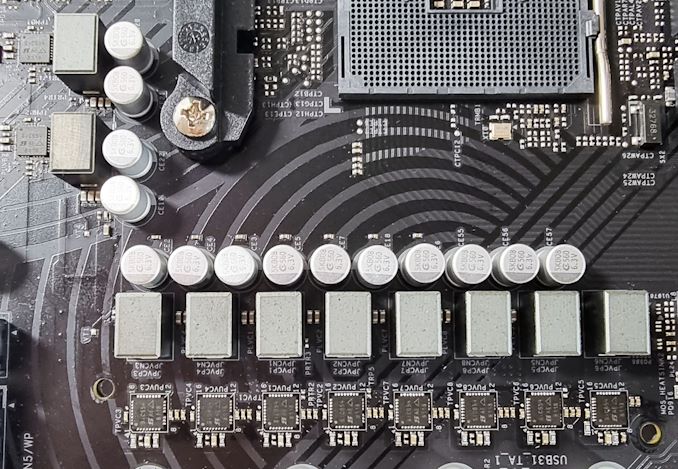
The 10-phase (8+2) power delivery operating at 4+2 on the ASRock X570S PG Riptide
Testing Methodology
Out method of testing out if the power delivery and its heatsink are effective at dissipating heat, is by running an intensely heavy CPU workload for a prolonged method of time. We apply an overclock which is deemed safe and at the maximum that the silicon on our AMD Ryzen 7 3700X processor allows. We then run the Prime95 with AVX2 enabled under a torture test for an hour at the maximum stable overclock we can which puts insane pressure on the processor. We collect our data via three different methods which include the following:
- Taking a thermal image from a birds-eye view after an hour with a Flir Pro thermal imaging camera
- Securing two probes on to the rear of the PCB, right underneath CPU VCore section of the power delivery for better parity in case the first probe reports a faulty reading
- Taking a reading of the VRM temperature from the sensor reading within the HWInfo monitoring application
The reason for using three different methods is that some sensors can read inaccurate temperatures, which can give very erratic results for users looking to gauge whether an overclock is too much pressure for the power delivery handle. With using a probe on the rear, it can also show the efficiency of the power stages and heatsinks as a wide margin between the probe and sensor temperature can show that the heatsink is dissipating heat and that the design is working, or that the internal sensor is massively wrong. To ensure our probe was accurate before testing, I binned 10 and selected the most accurate (within 1c of the actual temperature) for better parity in our testing.
For thermal image, we use a Flir One camera as it gives a good indication of where the heat is generated around the socket area, as some designs use different configurations and an evenly spread power delivery with good components will usually generate less heat. Manufacturers who use inefficient heatsinks and cheap out on power delivery components should run hotter than those who have invested. Of course, a $700 flagship motherboard is likely to outperform a cheaper $100 model under the same testing conditions, but it is still worth testing to see which vendors are doing things correctly.
Thermal Analysis Results

We measured 57.7°C on the hottest part of the CPU socket during our testing
The ASRock X570S PG Riptide is using a 10-phase power delivery, which is split into an 8-phase design for the CPU VCore, and a 2-phase setup for the SoC. The CPU section is using eight Vishay SIC654 50 A power stages operating with two UPI UP1911R smart PWM doublers that are quadrupling the power stages in a 4+0 configuration. The SoC is using two independent Vishay SIC654 50 A power stages, with a UPI UP9595S PWM controller operating in 4+2 mode. Cooling the power delivery is a single heatsink that doubles up as the board's rear panel cover. It's not very weighty and relies on good passive airflow over a large plate over the top of the heatsink.
Looking at how the ASRock X570S PG Riptide performed in our thermal VRM testing, it did pretty well considering it's an entry-level to mid-ranged X570(S) model. We measured a temperature of 63°C from our K-type thermocouple and got a reading of 57.7°C from the hottest part of the CPU socket area when using our FLIR thermal imaging camera. Unfortunately, the PG Riptide doesn't use an integrated VRM thermal sensor.
Comparing the PG Riptide to other AM4 models we've previously tested, it does sit near the warmer boards we've tested, but it's still well within specifications and performs as expected given the price point the board sits at.
Conclusion
With many premium X570 and now X570S models on the market, not everyone wants to pay through the nose to benefit from an entire string of PCIe 4.0 support. One of the main benefits of X570 and X570S involves full support for PCIe 4.0, including PCIe slots and all the M.2 storage too. This makes X570/S and a Ryzen 5000 one of the best combinations in terms of future-proofing and features.
I'm making the point that not every motherboard has to cost the earth, and the ASRock X570S PG Riptide slips right into the entry-level category as far as X570 and X570S go. It might still be an expensive board for some, at $185 which used to be the high-end pricing a decade ago! But with a lower than expected price compared to some of the more premium models, the PG Riptide spawns a new series for ASRock based on its already established Phantom Gaming series of models.
Its most prominent features include three full-length PCIe 4.0 slots operating at x16/+4/+2, with three PCIe 4.0 x1 slots. Storage is also varied with two PCIe 4.0 x4 M.2 slots, the second with support for SATA drives, with six SATA ports capable of running AMD RAID 0, 1, and 10 arrays.
When looking for a motherboard at such an entry-level model as the X570S PG Riptide, certain sacrifices have to be made for it to be cost-effective for the vendors to manufacturer it. This includes the use of an aging Realtek ALC897 HD audio codec. However, ASRock uses a premium Killer E3100G 2.5 GbE controller and offers a Key E M.2 slot for users to add whatever wireless interfaces they wish, such as a Wi-Fi 6 or even one of the newer Wi-Fi 6E controllers.
Connectivity isn't that bad for a sub $200 model such as this, as the ASRock includes one USB 3.2 G2 Type-C, one USB 3.2 G2 Type-A, four USB 3.2 G1 Type-A, and two USB 2.0 ports on the rear panel. Cooling support is also solid, with seven 4-pin headers. Although ASRock is advertising a 10-phase power delivery, it's more like a beefed-up 4+2 phase design - ASRock has tried to keep costs down by using two smart doublers.
Focusing on performance, the X570S PG Riptide does very well considering, as it is competitive with other AM4 models we've tested, including some of the most premium X570 models currently on the market. Our DPC latency testing showed that the Riptide isn't as good as others in audio workloads, but it's certainly good enough compared to others in terms of compute and gaming performance.
The other performance element comes in overclocking, and ASRock displayed some solid grit and determination in terms of VDroop control on the CPU VCore. We tested from 3.8 GHz all-cores all the way to 4.4 GHz all-cores and saw relative increases in POV-Ray performance, heat, and power consumption to boot. With our Ryzen 7 3700X processor, we managed a maximum stable overclock of 4.3 GHz, which is very respectable for an entry-level board, as only one board so far to date has managed to achieve beyond this; impressive.
Testing out the VRM thermal performance also puts the ASRock X570S PG Riptide in good stead, too, with respectable thermals given the power delivery heatsink isn't the most comprehensive we've seen, along with its simplistic yet unsimplistic VRM design at the same time. The temperatures topped out at 63°C from our K-type thermocouple, and the board doesn't feature an integrated VRM sensor to compare with.
Final Thoughts: Solid Value
The ASRock X570S PG Riptide has an MSRP of $185, making it more affordable than some B550 boards currently on the market. The caveat there is similar priced B550 models do include better-integrated audio, and some even include Wi-Fi 6 for a smidgen more. Looking at the PG Riptide for what it is, it's a competitive ATX sized offering with all of the benefits of PCIe 4.0, although users looking to run 2-way NVIDIA SLI won't be able to use this, with a lot of X570 models omitting this level of support; not that multi-GPU setups are commonly used these days anyway.
ASRock has a solid and cost-effective motherboard via the ASRock X570S PG Riptide, and it ticks a lot of boxes in the sub $200 marketplace. We would have liked to have seen a better power delivery and software bundle supplied with the board, but users looking to overclock will appreciate the intuitive and easy-to-use BIOS, and AMD's Ryzen Master overclocking utility does the job better than most vendors overclocking software anyway.
At $185, the ASRock X570S PG Riptide looks an excellent buy for users on a budget without sacrificing PCIe 4.0 support throughout and a 2.5 GbE controller which provides premium wired working for a reasonable price.

